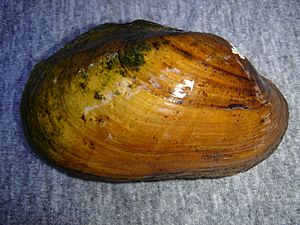Arkansas fatmucket facts for kids
Quick facts for kids Arkansas fatmucket |
|
|---|---|
 |
|
| Conservation status | |
| Scientific classification | |
| Genus: |
Lampsilis
|
| Species: |
powellii
|
The Lampsilis powellii is a special kind of freshwater mussel often called the Arkansas fatmucket. It's a rare animal found only in Arkansas, USA. This mussel lives in rivers like the Ouachita, Saline, and Caddo River. It's one of only two mussels that live only in Arkansas, the other being the speckled pocketbook. Because it's so rare, the United States government protects it as a threatened species.
Contents
What Does the Arkansas Fatmucket Look Like?
This mussel is a type of bivalve mollusc, which means it has two shells that open and close. It's shaped like a long oval and can grow to be more than 10 centimeters (about 4 inches) long. The outside of its shell can be brownish, olive green, or even a reddish-brown color. Inside, the shell is a shiny, bluish-white. You can tell the difference between male and female mussels by their shells: the male's shell is pointed at the back, while the female's is more rounded.
Where Does the Arkansas Fatmucket Live?
The Arkansas fatmucket likes to live in deep parts of rivers where the water flows enough to keep the area clean. It doesn't like fast-moving riffles or still pools where water doesn't move much. These mussels prefer sandy river bottoms, sometimes with rocks and gravel. They often live near river islands that have water willow plants (Justicia americana) growing in water about one meter (about 3 feet) deep.
Life Cycle and Reproduction
The way these mussels reproduce is quite interesting! When it's time to breed, the male mussel releases tiny sperm into the water. The female mussel then takes in the sperm from the water through her special tubes. The fertilized eggs stay safe inside the female's gills.
From Larva to Young Mussel
When the eggs hatch, they become tiny larvae called glochidia. These glochidia are then released into the water. To grow, they need to attach themselves to a fish. The adult female mussel has a special part of her body, called a mantle flap, that looks like a small fish. This trick helps to attract bigger fish closer. When a fish comes near, the glochidia can attach to its fins or gills. They then form a small cyst on the fish. Inside this cyst, the glochidia change and grow into tiny juvenile mussels. Once they are developed enough, they drop off the fish and settle onto the river bottom to continue growing into adult mussels.
Why Is the Arkansas Fatmucket Threatened?
This special mussel faces many dangers that make it hard for them to survive.
Habitat Changes
Many of the rivers where these mussels live have been blocked by dams. These dams create large lakes and reservoirs, like Lake Ouachita, Lake Hamilton, and Lake Catherine. This changes the rivers from flowing water to still lakes, which the mussels don't like. Also, parts of the rivers have been straightened and dug out, which destroys their natural homes.
Water Quality Problems
The rivers have also become filled with too much sediment (like dirt and sand). The water doesn't flow fast enough to wash this sediment away, so it builds up and covers the mussel's habitat. The water quality has also gotten worse because of pollution. For example, runoff from barite mining on the Caddo River and bauxite mining on the Saline River has polluted the water. Wastewater from homes and businesses also flows into a part of the Ouachita River. Other things that cause pollution include timber cutting, roads, and feedlots (where many farm animals are kept). Most of the land around these rivers is used for growing trees for wood, which can also affect the water.
See also
 In Spanish: Lampsilis powellii para niños
In Spanish: Lampsilis powellii para niños


